 W
WThe 26th Cavalry Regiment was part of U.S. Army Forces Far East's Philippine Department, during World War II. The 26th engaged in the last cavalry charge in the history of the U.S. cavalry. The American Battle Monuments Commission list 301 dead who were members of this regiment interred at Manila American Cemetery and Memorial.
 W
WThe 24th Field Artillery Regiment was a Philippine Scouts unit, part of the US Army's Philippine Division, formed in 1922 and active until April 1942. Antecedent units dated back to 1899.
 W
WThe 57th Infantry Regiment was a unit in the Philippine Scouts. During their combat in Bataan members received 1 Medal of Honor, 21 Distinguished Service Crosses and 68 Silver Stars.
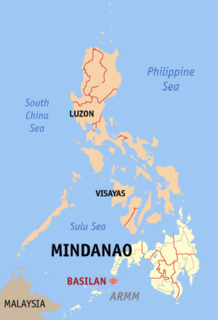 W
WBattle of Basilan was a military offensive launched by the Philippine military to apprehend two lead commanders in the Abu Sayyaf Islamic militia wanted for corruption, money laundering, and terrorism related charges. The main cause of the operation was Sayyaf leader Indama and his followers threatening and attempting to extort money from a circumferential road network. The two-day offensive ended with the both suspects evading capture and the island of Basilan falling under government authority. Both the army and MNLF collaborated in fighting alongside for a duration of the operation the first such instance since a truce. However collaborators within the Sayyaf militia included members of the MNLF who sympathized with their cause or had public relations with some of the militants.
 W
WThe Action of 30 October 1762 was a minor naval battle that was fought in the San Bernardino Strait off the coast off British occupied Manila in the Philippines between two Royal Navy ships and a Spanish ship; the 60 gun ship of the line HMS Panther under Captain Hyde Parker and the frigate HMS Argo under Richard King captured the heavily armed Spanish treasure galleon Santisima Trinidad.
 W
WThe Alex Boncayao Brigade, also known by the acronym ABB, was the urban assassination unit of the New People's Army, the armed wing of the Communist Party of the Philippines. Organized in 1984, the unit broke away from the New People's Army as a consequence of a split in ideology during the 1990s. In 1997, the Alex Boncayao Brigade allied itself with the Revolutionary Proletarian Army, the armed wing of the Revolutionary Workers' Party.
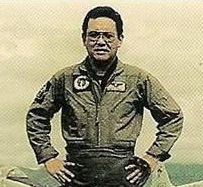 W
WDanilo S. Atienza was a Filipino pilot in the Philippine Air Force.
 W
WMary Grace Pango Baloyo was a Filipino flight officer in the Philippine Air Force who posthumously became the first female member of the Armed Forces of the Philippines to receive the Medal of Valor.
 W
WAntonio M. Bautista was an F-86 Sabre pilot who served in the Philippine Air Force. He served in the aerobatic display team the Blue Diamonds and fought against rebels in the south of the country. He was killed in action in January 1974.
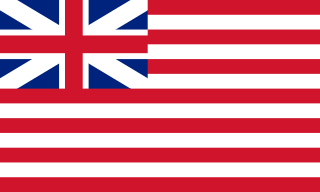 W
WThe British occupation of Manila was an episode in Philippine colonial history when the British Empire occupied the Spanish colonial capital of Manila and the nearby principal port of Cavite for twenty months between 1762 and 1764. The occupation was an extension of the larger Seven Years' War between Britain and France, but which came to involve Spain.
 W
WThe Capas National Shrine in Barangay Aranguren, Capas, Tarlac, Philippines was built by the Philippine government as a memorial to Allied soldiers who died at Camp O'Donnell at the end of the Bataan Death March during the Second World War.
 W
WThe 1957 crash of a Douglas C-47 plane named Mt. Pinatubo on the slopes of Mount Manunggal, Cebu, Philippines, killed the seventh President of the Philippines, Ramon Magsaysay, and 24 other passengers. The crash is estimated to have occurred at 1:40 a.m., March 17, 1957, Philippine Standard Time. Several high-ranking Philippine government and military officials, as well as journalists, were also among the dead. A reporter for the Philippine Herald, Nestor Mata, was the sole survivor of the accident.
 W
WThe Chief of the Army is the overall commander and senior general of the Philippine Army, the ground warfare branch of the Armed Forces of the Philippines. It is normally held by a three-star rank of Lieutenant General and was formerly known as the "Commanding General of the Philippine Army (CGPA)" until June 2020. He has operational control and is responsible for overall operations of the army, and directly reports to the Chairman of the Joint Chiefs.
 W
WThe communist rebellion in the Philippines is an ongoing conflict between the Government of the Philippines (GPH) and the New People's Army (NPA), which is the armed wing of the Marxist-Leninist-Maoist Communist Party of the Philippines (CPP). The conflict is also associated with the National Democratic Front of the Philippines (NDFP), which serves as the political wing of the CPP.
 W
WAhod Balawag Ebrahim, better known as Al-Hajj Murad Ebrahim, is a Moro Filipino politician and former rebel leader currently serving as the first and interim Chief Minister of the Bangsamoro Autonomous Region in Muslim Mindanao.
 W
WHugh Bryan Hester was an Army Brigadier General. He was a decorated officer in both World Wars. Later in life, he was a noted critic of U.S. foreign policy.
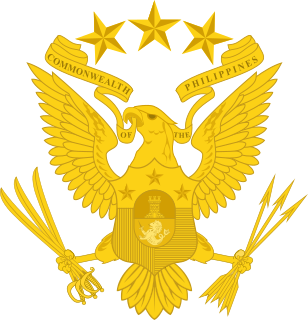 W
WThe Philippine Army was established on December 21, 1935 as the Army of the Philippines, with a general headquarters in Manila, and units and formations based throughout the provinces of the Philippines.
 W
WThe Jabidah massacre was a massacre of Moro army recruits by members of the Armed Forces of the Philippines (AFP) on March 18, 1968, which is acknowledged as a major flashpoint that ignited the Moro insurgency in the Philippines.
 W
WKhalifa Islamiyah Mindanao (KIM) was a dedicated organization that sought to establish an independent state in Mindanao, Philippines. The group was led by an Afghan-trained cleric known as Humam Abdul Najid. It was sometimes described as an umbrella organization composed of the Jemaah Islamiyah, the Abu Sayyaf, and members of other armed groups. According to the Philippine Institute for Peace, Violence and Terrorism Research, the KIM had five founders; Zulkifli Abdhir, who was killed on January 25, 2015 by Special Action Force officers during the raid that culminated in the Mamasapano clash, Amir M, Amir Abtol Rahman, Amir Kuptu and Amir Humam Abdul Najid. The group has reportedly adopted the flag of the Islamic State of Iraq and the Levant.
 W
WThis list of conflicts in the Philippines is a timeline of events that includes pre-colonial wars, Spanish–Moro conflict, Philippine revolts against Spain, battles, skirmishes, and other related items that have occurred in the Philippines' geographical area.
 W
WThis is a list of direct armed conflicts involving the Philippines since its founding during the Philippine revolution.
 W
WThis is the list of the Weapons used in the Philippine revolution.
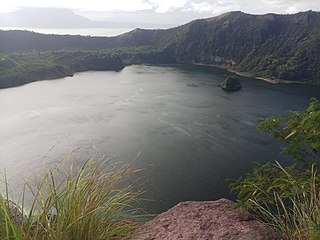 W
WThe Luzon rain forests is a tropical moist broadleaf forest ecoregion on the island of Luzon. Luzon is the largest island in the Philippines, and the Luzon rain forests is the most extensive rainforest ecoregion of the country. The ecoregion includes the lowlands of Luzon and neighboring islands below 1000 meters elevation. Very little of the original rainforest remains, and the status of this area is critical/endangered.
 W
WGeneral of the Army Douglas MacArthur was an American five-star general and Field Marshal of the Philippine Army. He was Chief of Staff of the United States Army during the 1930s and played a prominent role in the Pacific theater during World War II. He received the Medal of Honor for his service in the Philippines campaign, which made him and his father Arthur MacArthur Jr. the first father and son to be awarded the medal. He was one of only five to rise to the rank of General of the Army in the US Army, and the only one conferred the rank of field marshal in the Philippine Army.
 W
WThe Battle of Mactan was fought in the Philippines on 27 April 1521. Warriors of Lapulapu, a native chieftain of Mactan, overpowered and defeated a Spanish force fighting for Rajah Humabon of Cebu under the command of Portuguese explorer Ferdinand Magellan, who was killed in the battle. The outcome of the battle resulted in the departure of the Spanish crew from the archipelago, and delayed the Spanish colonization of the Philippines by 44 years until the conquest by Miguel López de Legazpi in 1564–1565.
 W
WThe Magdalo Group was a group of dissident soldiers who staged the unsuccessful Oakwood mutiny. Made up of junior officers of all branches of the Armed Forces of the Philippines, they took over the Oakwood Premier Ayala Center in Makati and demanded the resignation of senior officers in the AFP and members of the Arroyo government, including the President herself. The group called themselves "Bagong Katipuneros", however, the local press continues calling them the Magdalo Group.
 W
WThe Battle of Manila was fought during the Seven Years' War, from 24 September 1762 to 6 October 1762, between the Kingdom of Great Britain and the Kingdom of Spain in and around Manila, the capital of the Philippines, a Spanish colony at that time. The British won, leading to a twenty-month occupation of Manila.
 W
WMartial law in the Philippines refers to several intermittent periods in Philippine history wherein the Philippine head of state places an area under the control of the Armed Forces of the Philippines and its predecessor bodies. Martial law is declared when there is violent civil unrest; most countries use a different legal construct like "state of emergency".
 W
WThe Moro conflict, is an insurgency in the Mindanao region of the Philippines which has been ongoing since 1969, though non-Jihadist insurgency ended in 2019.
 W
WThe Moro Islamic Liberation Front is a group based in Mindanao, Philippines seeking an autonomous region of the Moro people from the central government. The group has a presence in the Bangsamoro region of Mindanao, the Sulu Archipelago, Palawan, Basilan, and other neighbouring islands.
 W
WThe National Defense Act of 1935 was passed by the Philippine National Assembly on December 21, 1935. The purpose of this act was to create an independent Philippine military, a move interrupted by the outbreak of the Second World War.
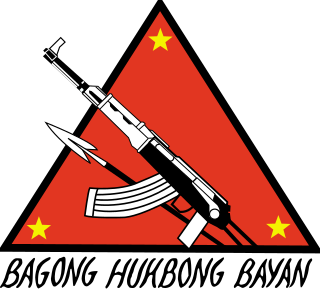 W
WThe New People's Army, abbreviated NPA or BHB, is the armed wing of the Communist Party of the Philippines (CPP), based primarily in the Philippine countryside. It acts as the CPP's principal organization, aiming to consolidate political power from what it sees as the present "bourgeois reactionary puppet government" and to aid in the "people's democratic revolution". Founded on March 29, 1969, by the collaboration of Jose Maria Sison and former members of the Hukbong Mapagpalaya ng Bayan led by Bernabe Buscayno, the NPA has since waged a guerrilla war based on the Maoist strategy of protracted people's war. The NPA is one of the key figures in the ongoing CPP–NPA–NDF rebellion in the Philippines, the longest ongoing conflict in the country.
 W
WThe Oakwood mutiny occurred in the Philippines on July 27, 2003. A group of 321 armed soldiers who called themselves "Bagong Katipuneros" led by Army Capt. Gerardo Gambala and Lt. Sg. Antonio Trillanes IV of the Philippine Navy took over the Oakwood Premier Ayala Center serviced apartment tower in Makati to show the Filipino people the alleged corruption of the Gloria Macapagal-Arroyo administration. They also stated that they saw signs suggesting that the President was going to declare martial law.
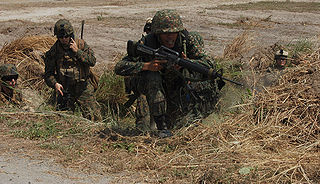 W
WOperation Enduring Freedom – Philippines (OEF-P) or Operation Freedom Eagle was part of Operation Enduring Freedom and the global War on Terror. The Operation targeted the various Jihadist terror groups operating in the country. By 2009, about 600 U.S. military personnel were advising and assisting the Armed Forces of the Philippines (AFP) in the Southern Philippines. In addition, by 2014, the CIA had sent its elite paramilitary officers from their Special Activities Division to hunt down and kill or capture key terrorist leaders. This group had the most success in combating and capturing Al-Qaeda leaders and the leaders of associated groups like Abu Sayyaf.
 W
WThe People Power Revolution was a series of popular demonstrations in the Philippines, mostly in Metro Manila, from February 22–25, 1986. There was a sustained campaign of civil resistance against regime violence and electoral fraud. The nonviolent revolution led to the departure of Ferdinand Marcos, the end of his 20-year presidential term and the restoration of democracy in the Philippines.
 W
WThe Philippine Congressional Medal was a service medal of the United States Army which was established by the United States Congress on 9 July 1906. The medal recognized those soldiers who had enlisted in the United States Army for the purpose of the serving in the Philippine–American War.
 W
WThe Philippine Constabulary was a gendarmerie-type police force of the Philippines from 1901 to 1991, and the predecessor to the Philippine National Police. It was created by the American colonial government to replace the Spanish colonial Guardia Civil. It was the first of the four branches of the Armed Forces of the Philippines. On January 29, 1991, it was merged with the Integrated National Police to form the Philippine National Police.
 W
WThe Philippine Department was a regular United States Army unit whose mission was to defend the Philippine Islands and train the Philippine Army. On 9 April 1942, during World War II, the unit surrendered to the Japanese. The Department and its sub-units were predominantly under the command of American officers, including an American general, while the majority of the troops were enlisted Filipinos, known as the Philippine Scouts (PS). The primary force of this Department was the Philippine Division. Of the 22,532 troops, 10,473 were members of the Philippine Division itself.
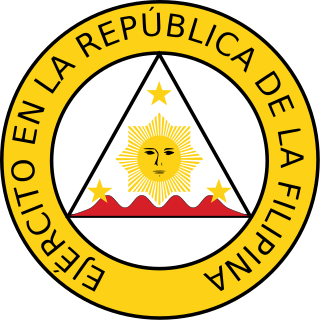 W
WThe Philippine Revolutionary Army later renamed Philippine Republican Army..
 W
WThe Philippine Scouts was a military organization of the United States Army from 1901 until after the end of World War II. These troops were generally Filipinos and Filipino-Americans assigned to the United States Army Philippine Department, under the command of American commissioned officers. Philippine Scout units were given the suffix "(PS)", to distinguish them from other U.S. Army units.
 W
WRayadillo was a blue-and-white striped cotton fabric used to make the military uniforms worn by Spanish colonial soldiers from the mid 19th century until the early 20th Century. Known by the British as "pyjamas", due to their resemblance with sleeping garments, it was commonly worn amongst soldiers posted in overseas Spanish tropical colonies and later, Spanish Morocco and Spanish Guinea. It became popular after being worn during the Spanish–American War, and was later adopted by the Philippine Army. It also served as the summer uniform of the regular army in Spain until 1914.
 W
WPaciano Rizal Mercado y Alonso Realonda was a Filipino general and revolutionary, and the older brother of José Rizal, the national hero of the Philippines.
 W
WPaulino Torres Santos was a military officer who became the Commanding General of the Philippine Army from May 6 to December 31, 1936. Upon his retirement, he served as a civilian administrator under President Manuel L. Quezon.
 W
WThe Siege of Saigon, a two-year siege of the city by the Vietnamese after its capture on 17 February 1859 by a Franco-Spanish flotilla under the command of the French admiral Charles Rigault de Genouilly, was one of the major events of the Conquest of Cochinchina (1858–62). Saigon was of great strategic importance, both as the key food-producing area of Vietnam and as the gateway to Cochinchina.
 W
WThe Balanguingui Expedition of 1848 was an amphibious campaign organized by Governor General Narciso Clavería y Zaldúa to capture Balanguingui Island in the Sulu Archipelago from the Moro Pirates, who were using it as a base for their piratical activities.
 W
WThe Spanish–Moro conflict was a series of battles in the Philippines lasting over several centuries. It began during the Spanish Era until the Spanish–American War when Spain finally began to subjugate the Moro people after centuries of failing to do so.
 W
WPablo Ocampo Tecson was an officer in the Revolutionary Army serving under Gen. Gregorio del Pilar and a representative to the Malolos Congress. He was elected the Governor General of Bulacan immediately following the Philippine–American War. Tecson later served as Insular Secretary of the Philippine Bureau of Agriculture.
 W
WThe Siege of Tourane was a Vietnamese victory during the Cochinchina Campaign, a punitive campaign against the Vietnamese launched by France and Spain in 1858. A joint Franco-Spanish expedition under the command of Admiral Charles Rigault de Genouilly captured Tourane in September 1858, but was then besieged in the city by the Vietnamese and forced eventually to evacuate it in March 1860.
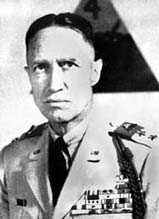 W
WThomas John Hall "Trap" Trapnell was a United States Army lieutenant general. He was a career officer who served in World War II and the Korean War. Trapnell survived the Bataan Death March and the sinking of two transportation ships during World War II, put down a rebellion of prisoners of war in the Korean War, was the top US advisor to the French during the French Indochina War, and advised against US involvement in Vietnam. He rose to the rank of three-star general before his military retirement and, at the time of his death, was the oldest living member of the Philippine Scouts.
 W
WBasilio José Segundo Pica Valdés was a Spanish Filipino doctor, general and minister. Valdes was chief of staff of the Armed Forces of the Commonwealth of the Philippines from 1939, and was in 1941 appointed Secretary of National Defense by President Manuel L. Quezon. After the Japanese invasion of the Philippines at the beginning of the Second World War, he was one of the members of Quezon's war cabinet in exile.
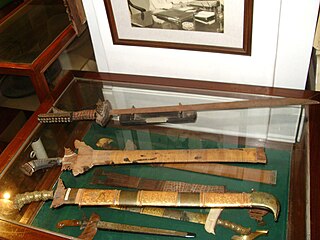 W
WWarfare in pre-colonial Philippines refers to the military history of the Philippines prior to Spanish colonization.